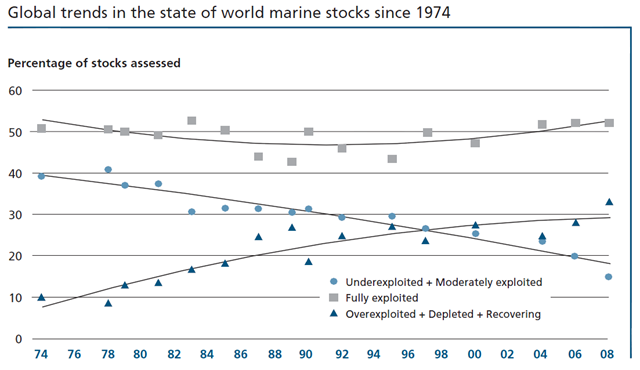Graph of the Day: Global Trends in World Marine Stocks, 1974-2008
The proportion of stocks estimated to be underexploited or moderately exploited declined from 40 percent in the mid-1970s to 15 percent in 2008. In contrast, the proportion of overexploited, depleted or recovering stocks increased from 10 percent in 1974 to 32 percent in 2008. The proportion of fully exploited stocks has remained relatively stable at about 50 percent since the 1970s, with scattered, slightly lower levels between 1985 and 1997. In 2008, 15 percent of the stock groups monitored by FAO were estimated to be underexploited (3 percent) or moderately exploited (12 percent) and, therefore, able to produce more than their current catches. This is the lowest percentage recorded since the mid-1970s. Slightly more than half of the stocks (53 percent) were estimated to be fully exploited and, therefore, their current catches are at or close to their maximum sustainable productions, with no room for further expansion. The remaining 32 percent were estimated to be either overexploited (28 percent), depleted (3 percent) or recovering from depletion (1 percent) and, thus, yielding less than their maximum potential production owing to excess fishing pressure in the past, with a need for rebuilding plans. This combined percentage is the highest in the time series. While the degree of uncertainty about these estimates may be great (Box 1), the apparently increasing trend in the percentage of overexploited, depleted and recovering stocks and the decreasing trend in underexploited and moderately exploited stocks do give cause for concern.
The State of World Fisheries and Aquaculture 2010 [pdf], FAO Fisheries and Aquaculture Department, Food and Agricultural Organization of the United Nations, Rome, 2010
